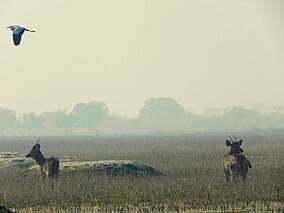Keoladeo National Park
| Keoladeo Ghana National Park | |
|---|---|
|
IUCN category II (national park)
|
|

Keoladeo Ghana National Park, Bharatpur, Rajasthan, India
|
|
| Location | Bharatpur, Rajasthan, India |
| Nearest city | Bharatpur, Rajasthan |
| Coordinates | 27°10′00″N 77°31′00″E / 27.166667°N 77.516667°ECoordinates: 27°10′00″N 77°31′00″E / 27.166667°N 77.516667°E |
| Area | 2,873 hectares (7,100 acres; 11.1 sq mi; 28.7 km2) |
| Established | 10 March 1982 |
| Visitors | 100,000 (in 2008) |
| Governing body | Rajasthan Tourism Development Corporation |
| Type | Natural |
| Criteria | X |
| Designated | 1985 (9th session) |
| Reference no. | 340 |
| State Party | India |
| Region | Asia-Pacific |
| Designated | 1 October 1981 |
Keoladeo National Park or Keoladeo Ghana National Park formerly known as the Bharatpur Bird Sanctuary in Bharatpur, Rajasthan, India is a famous avifauna sanctuary that hosts thousands of birds, especially during the winter season. Over 230 species of birds are known to be resident. It is also a major tourist centre with scores of ornithologists arriving here in the hibernal season. It was declared a protected sanctuary in 1971. It is also a World Heritage Site.
Keoladeo Ghana National Park is a man-made and man-managed wetland and one of the national parks of India. The reserve protects Bharatpur from frequent floods, provides grazing grounds for village cattle, and earlier was primarily used as a waterfowl hunting ground. The 29 km2 (11 sq mi) reserve is locally known as Ghana, and is a mosaic of dry grasslands, woodlands, woodland swamps and wetlands. These diverse habitats are home to 366 bird species, 379 floral species, 50 species of fish, 13 species of snakes, 5 species of lizards, 7 amphibian species, 7 turtle species, and a variety of other invertebrates. Every year thousands of migratory waterfowl visit the park for wintering and breeding. The sanctuary is one of the richest bird areas in the world and is known for nesting of resident birds and visiting migratory birds including water birds. The rare Siberian cranes used to winter in this park but this central population is now extinct. According to founder of the World Wildlife Fund Peter Scott, Keoladeo National Park is one of the world’s best bird areas. Alongwith the Loktak Lake of Manipur, Keoladeo National Park is placed on the Montreux Record under the Ramsar Convention.
The sanctuary was created 250 years ago and is named after a Keoladeo (Shiva) temple within its boundaries. Initially, it was a natural depression; and was flooded after the Ajan Bund was constructed by Maharaja Suraj Mal, then the ruler of the princely state of Bharatpur, between 1726–1763. The bund was created at the confluence of two rivers, the Gambhir and Banganga. The park was a hunting ground for the maharajas of Bharatpur, a tradition dating back to 1850, and duck shoots were organised yearly in honor of the British viceroys. In one shoot alone in 1938, over 4,273 birds such as mallards and teals were killed by Lord Linlithgow, the then Governor-General of India.
...
Wikipedia

